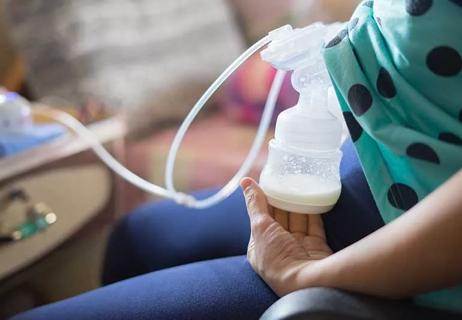Take your time, pick the right time and employ feeding time-limits

When you’re breastfeeding (chestfeeding), there’s a good chance you’ve spent more mornings, mid-mornings, afternoons, evenings (and nights!) nursing your little one than you can even count.
Advertisement
Cleveland Clinic is a non-profit academic medical center. Advertising on our site helps support our mission. We do not endorse non-Cleveland Clinic products or services. Policy
That’s a good thing — after all, the American Academy of Pediatrics recommends breastfeeding exclusively for your baby’s first six months and then gradually introducing solid foods. After that, AAP recommends breastfeeding for up to two years. The World Health Organization recommends breastfeeding for the same period of time.
Of course, your baby or toddler will be ready to wean — eventually. “Weaning is a bit of a difficult topic,” says pediatrician Heidi Szugye, DO, IBCLC, the medical director of Cleveland Clinic’s Breastfeeding Medicine Clinic & Center. “Every baby — and every parent — is different.”
Dr. Szugye offers practical tips for easing the transition for your little one and making the process as guilt-free as possible for you.
In some cases, your baby or toddler will let you know they’re ready to wean by becoming disinterested in breastfeeding. Maybe you’ve birthed an independent child who’ll decide on their own if they’re done.
But you can’t necessarily count on either of these things. “Looking at mammals in general, studies have shown it’s actually pretty rare for an infant or a child to self-wean before the age of 2 to 4,” Dr. Szugye says. “Most often, it’s a parent deciding to wean before that time period.”
Advertisement
Dr. Szugye stresses that the decision to wean — and the reasons for weaning — look different for each family.
For example, babies will sometimes develop a bottle preference when their parent returns to work. “That makes breastfeeding a little more difficult,” Dr. Szugye notes.
But breastfeeding becoming a challenge isn’t necessarily a sign it’s time to wean. “We know 60% of parents are not breastfeeding for as long as they intended to,” Dr. Szugye states. “And they wean because they’re experiencing some sort of breastfeeding challenge.
“As doctors, we want to make sure that we understand the reason for weaning. If it’s something we can help them work through, then we want to provide them with that support first.”
Every parent’s weaning experience is different. But Dr. Szugye shares some universal tips to make the journey easier.
Sometimes, there are medical reasons that a parent needs to wean from breastfeeding quickly. Your milk supply will also dictate the parameters of your weaning process. “Someone who has an oversupply of milk is going to take a lot longer to wean than someone who has an undersupply,” notes Dr. Szugye.
But if possible, slow and steady is best. Weaning too quickly puts you at risk of developing mastitis (a breast infection of the milk duct) or plugged milk ducts.
“There have also been studies showing that weaning quickly can affect your mood,” states Dr. Szugye. “So, if you wean quickly and stop breastfeeding cold turkey, you have an increased risk for anxiety and depression. That’s because many hormones that are involved with making the milk also play into our mood stability.”
But she reiterates that weaning looks different for everybody. “Some people can wean more quickly than others. You want to go based on your comfort level.”
If you’re trying to wean a younger baby, you have the advantage of being able to control your baby’s environment.
Another parent or family member can begin offering a bottle during the transition. It’s also best if the bottle feeding is done in a different place than you normally breastfeed (without you in the room). The change in routine will make it less likely your baby will feel the natural triggers involved with breastfeeding.
If you know in advance when you’ll need to wean ― for example, maybe you have a date you’re returning to work ― it’s a good idea to begin intermittently introducing a bottle. Find a nipple for the bottle that’s closest to your breast shape to ease the transition further.
Weaning an older child is sometimes slightly more (or a lot more) challenging. The most common strategy is to drop one feeding each week, starting with your child’s least favorite one. This gives your breasts time to adjust production in response to the lowering demand.
Advertisement
With an older child, you can use distractions (playing outside or reading a favorite book, for example) to delay or end a feeding session.
Employ time-limiting tricks to shorten feedings. Set a “timer” by turning on a song and letting your child know they can only nurse until the song is over.
You can also offer healthy snacks or water shortly before a normal nursing time. This can limit (or completely eliminate) the need to nurse.
Weaning is much more challenging at a few times, including when your baby is teething, particularly fussy or sick. It’s easier when things are running smoothly in their world.
Remember what you enjoyed about breastfeeding in the first place — it isn’t just about the milk, but the closeness and comfort as well. It’s a good idea to offer plenty of physical interaction and attention for your baby during this transition time — maybe even more than usual.
If you’re having a lot of engorgement or discomfort when you’re weaning, you want to pump or hand-express your breast milk to make yourself feel comfortable. Ice packs can also be helpful if you’re uncomfortably full.
“You don’t want to fully empty your breast,” advises Dr. Szugye. “When your breasts are completely empty, this is a sign for your body to make more milk.”
Advertisement
Unfortunately, you can’t adjust what your baby (or your body) wants with the switch of a button. In other words, this transition won’t happen overnight.
Whenever you decide to wean your baby, remember that you don’t have to do it all at once. The process works best when done gradually and flexibly.
“There’s a big misconception out there that you either breastfeed all the time — or stop completely,” says Dr. Szugye. “It doesn’t need to be all or nothing. When you decide that maybe you don’t want to breastfeed as much, it doesn’t mean that you need to completely stop and wean overnight.
For example, maybe you’ll choose to stop pumping but still decide to breastfeed at night. “You don’t have to breastfeed eight times a day to breastfeed. You can breastfeed once at night before bedtime. A lot of parents like that bonding experience with their baby,” she adds.
If your child isn’t ready to wean, don’t get discouraged. All babies will wean eventually — some just take more time than others.
But if you’re not sure if you’re on track with breastfeeding or weaning, talk to your child’s pediatrician or your Ob/Gyn. Lactation consultants can also be a big help. “As healthcare providers, it’s our job to make sure we’re supporting you through challenges, and also providing you with all the options and alternatives that are out there as well,” encourages Dr. Szugye.
Advertisement
“The decision to wean, and the reasons behind weaning, are different for every family. As healthcare providers, we’re here to support you every step of the way.”
Learn more about our editorial process.
Advertisement

When breastfeeding doesn’t go as planned, you may need to supplement with formula or donor breast milk — and that’s OK

Breastfeeding supplements can be a needless expense at best, and risky at worst

Typically, milk comes in a few days after birth and regulates around four weeks after delivery

From the football hold to the cradle hold, consider trying a variety of techniques

Gentle massaging, lying on your side and hand-expressing a little milk can help

Get your milk flowing by getting comfy, releasing stress and focusing on your baby

Popular myth says breastfeeding prevents pregnancy, but that’s not the whole story

With some exceptions, most are OK

Type 2 diabetes isn’t inevitable with these dietary changes

Applying a hot or cold compress can help with pain